Zoho Creator Review
Zoho Creator is a tool designed to "build apps that are perfect for your business" and has been around for a while now as part of Zoho Corporation's suite of Apps (which include CRM, Finance, HR, Collaboration, Help Desk etc). Zoho's intention is to become 'the Operating System for Business'.
Within the Zoho suite, Creator is the tool you would use to build solutions which are specific for your business - and where simply customising one of their other services wouldn't meet your needs. There are a huge number of options in Creator and I will only be able to scratch the surface in this review but I hope that, by the end, you will have a good idea of its capabilities.
Getting Started - Building your first App
Creating a new app starts from the Creator home page - from where you can click New Application. As with some of the previous reviews, I am going to base this review on an HR app - one, in fact, that I am actively working on for the Zoho Marketplace - which I've named KasPer HR.
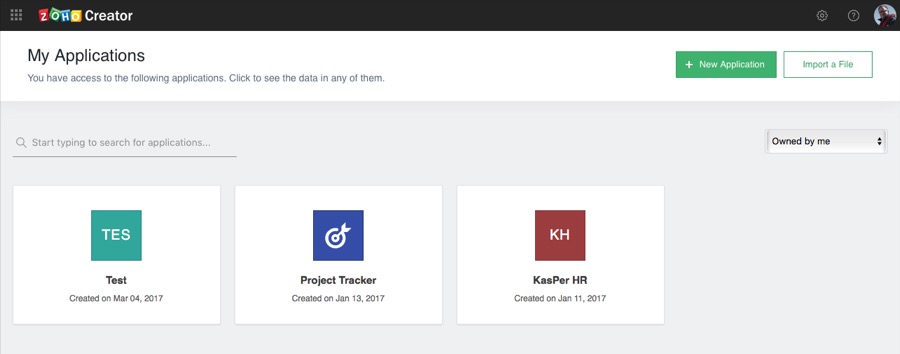
With Zoho, you start by building 'Forms'. This process creates both a form which is used for adding and editing data and also the underlying database table and all its fields. Here is an example of the dashboard within Creator where you can see all the forms and other items in the app:
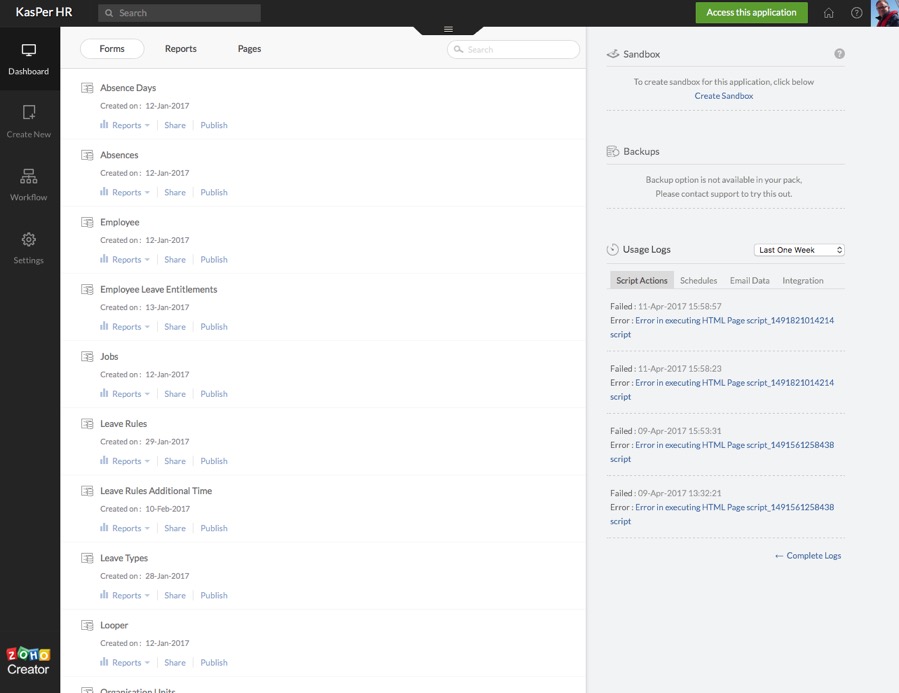
Let's have a look at the Employee 'Form':
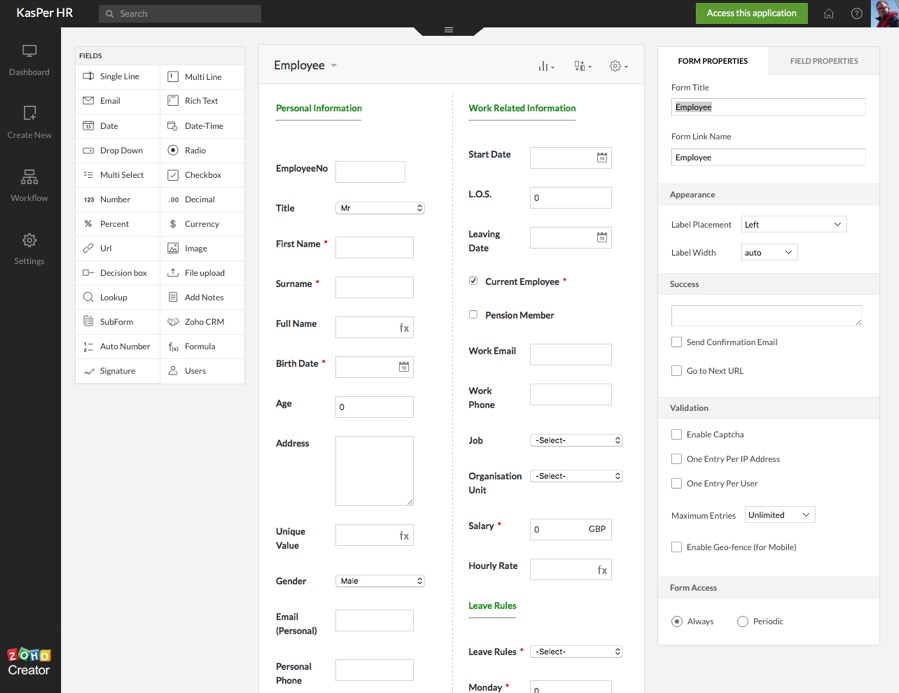
Hopefully, you can see the wide range of options available for the form overall - as well as the number of different field types including file upload, images, formula fields, signatures etc. Some of these are mobile enabled - you can capture signatures and take photos on your device for example. There's plenty of flexibility here to store all your data! In run mode this form looks like this:
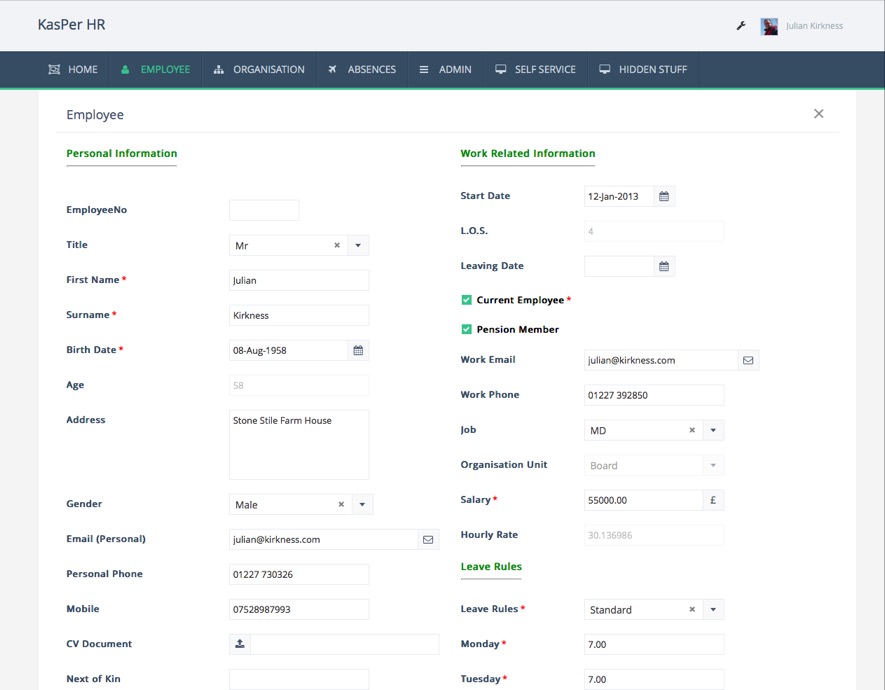
When you create a 'form' the system also creates an associated Report which are used to navigate through records, select records for single or batch edits, delete, etc. Reports can also be displayed in a number of formats (Lists, Calendars, Charts, etc) and you can perform groupings, selections and so on. Here is a screenshot of a basic list report based upon Employees:
In Design View:
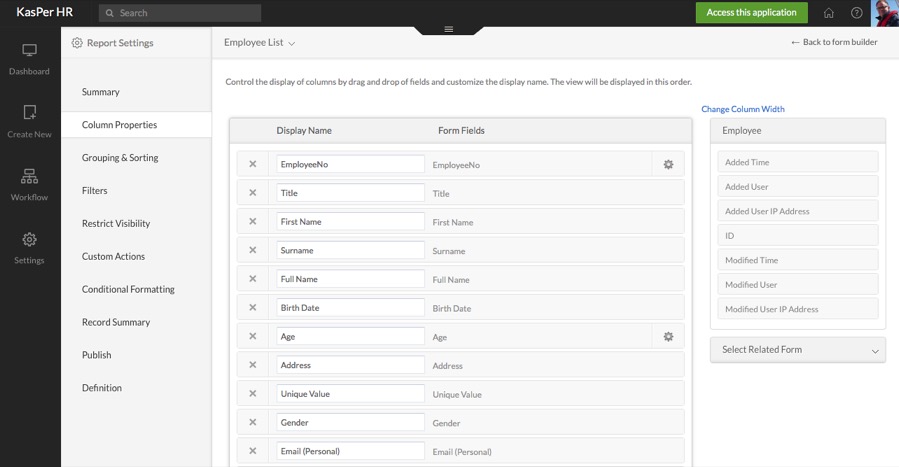
And this is what it looks like at runtime:
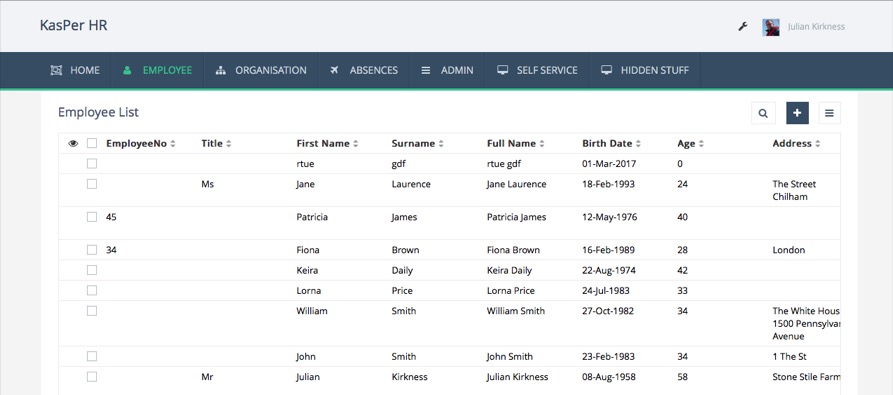
This is effectively the default report for this Form - and includes all fields in the form. You have a number of ways to customise this - for example you can hide fields by either removing them from the report in design view or, using the Eye symbol top left you can remove them in runtime. In design view you can also add grouping, sorting and selection criteria:

Here, for example, I am grouping by 'Organisation Unit' and sorting by Full Name.
In the Filter section, you can enable and disable default filtering options available to users of the application and also build custom filters for the report:
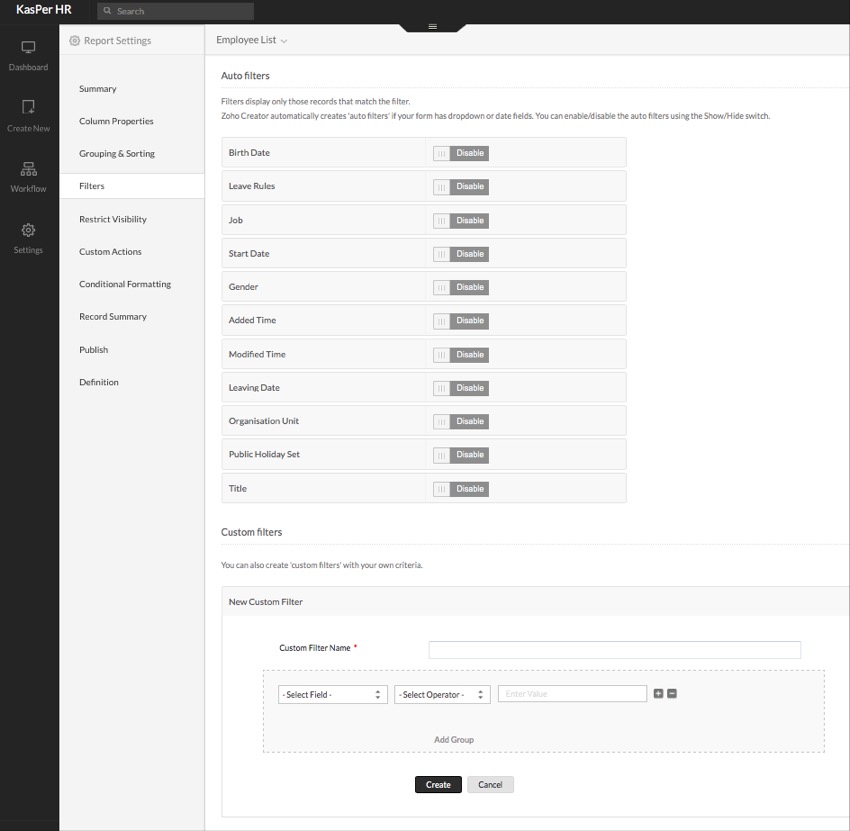
If you wanted to provide a custom filter for your users which would limit the report to only Current Employees (assuming you had a tick box for this) you would do this:
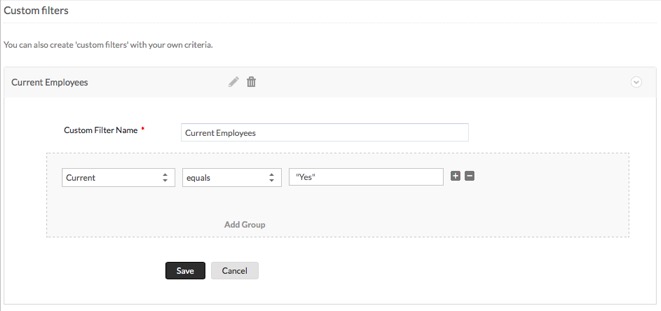
When the report is run, users can choose to apply the filter:
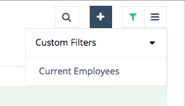
There are many more options for your reports including which users can access them, conditional formatting, 'custom actions' (more later), etc. The employee listing below, for example, has leavers greed out and some buttons which perform 'custom actions':
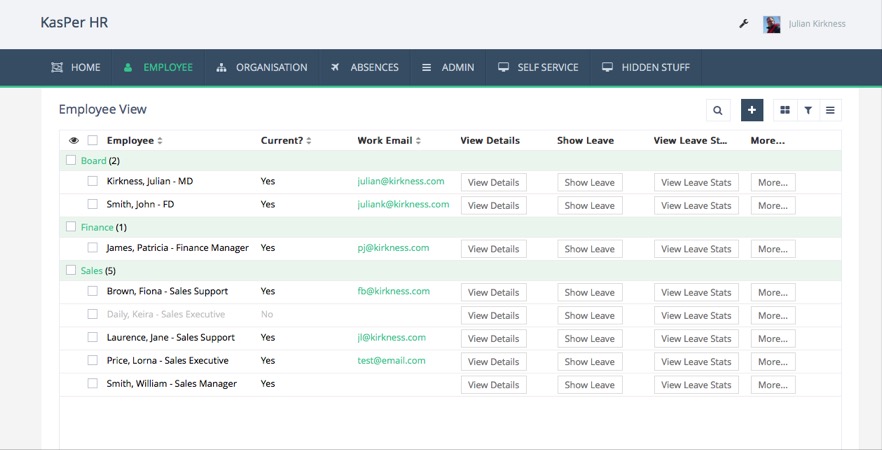
Relating Data
Relational data is fully supported within Creator and is simple to configure - by simply adding a Lookup field to a child record for example. Once you have your relationship, you can manipulate related data, add to forms in Subforms and perform sums and calculations.
You should be aware that one feature missing is the ability to perform automatic cascade deletes when a 'parent' record is removed from the database. However, it is very easy to implement this is Creator's Deluge Language with a Deluge script associated with the Validate action when a record is deleted:

In this example, records are deleted from two 'sub' tables (which would otherwise be 'orphaned').
Business Intelligence and Dashboards
We have already seen how you can produce listing and other reports (eg. Calendars or Grid views) which can be used for both information display and system navigation purposes. You are also able to create Pivot Charts and Pivot Tables - which are great ways of presenting information to users - and in Creator these also have drill down capabilities allowing users to see what's behind the presentation. There are helpful features when dealing with dates so that information can be displayed by - here's an example grouped by month for an Absence by Month graph:
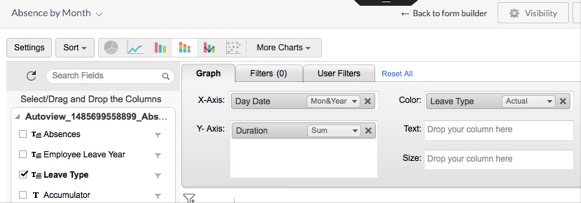
And this is what the end result looks like:
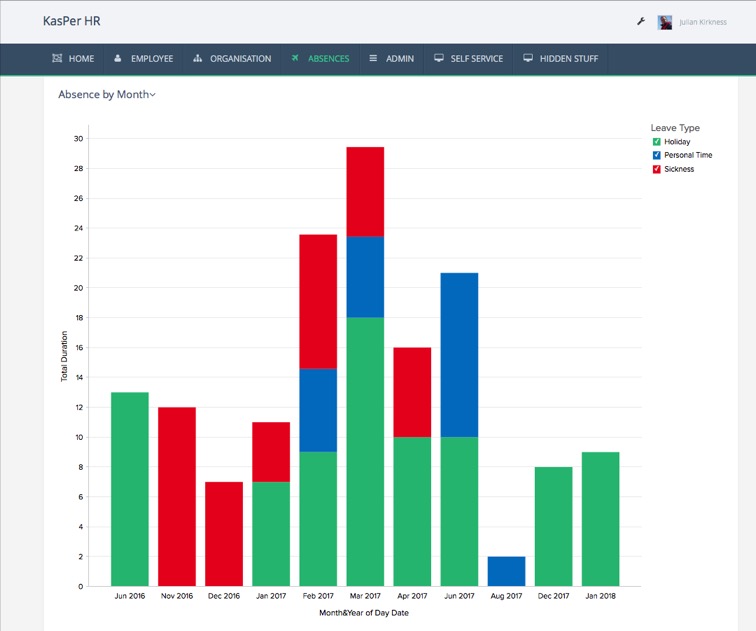
Notice how the legend can be used to filter the graph by simply selecting and deselecting the leave type.
In addition to reports in their various formats, you also have the ability to create 'Pages' which enable you to group data from multiple reports (or retrieved using Deluge) on a single page. This enables the production of multi faceted dash boards and navigation scenarios. Pages are created with a combination of HTML and Deluge script together with drag and drop editing (especially with the New Page Builder currently being beta tested).
Mobile
As I mentioned briefly above, Zoho Creator includes a mobile app with which your solutions can be used on a mobile device (iOS, Android - phone and tablet) without modification - even with Offline mode if you are on a premium account or above!
This takes the form of a (free) app from the relevant app store which acts as a container for your Zoho Creator solutions, showing you a list of your apps and allowing full use of them on the move:

The middle screenshot shows a list of your apps and we also have a screen in edit mode, a Calendar, a Report listing employees and an example of a graph (Absences by Month - which is the same as that shown above so that you can compare).
With this latest update to the mobile app (released around 25th April 2017), usability on a phone has improved significantly. I believe Zoho really understand the importance of being able to build Web and Mobile solutions using the same tooling and techniques.
Style and Layout
I have shown all of the example screenshots so far using the same Theme - but there are a number of options available - here is an alternative showing red highlights and the menus down the left:
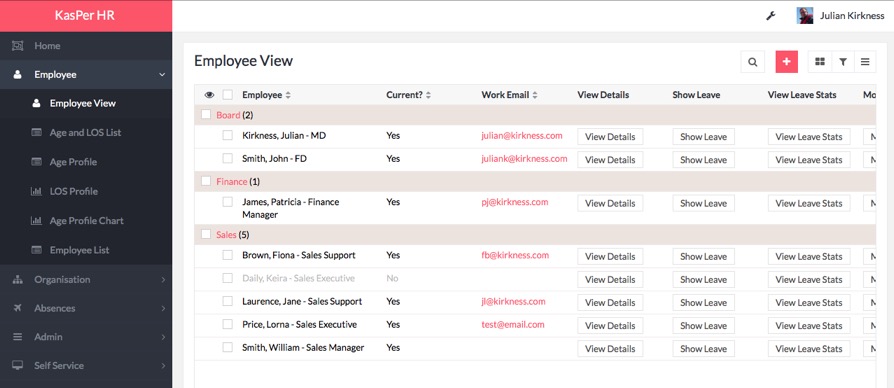
Security
Creator has comprehensive built in security (with more features available in the Paid plans) and is clever enough to automatically hide things from users if they don't have access. This means that is is fairly easy to build a solution with multiple use cases for different groups of users.
Subject to your plan, there is also a feature called 'Customer Portal' which allows you to build an unbranded portal for external users. This can also be fully secured and users can be allowed to either create their own accounts or they can be created for them.
Customisation and Coding
Zoho has a lot of flexibility when it comes to laying out your menus and structuring your application (especially through the judicious use of Pages).
I would personally describe Zoho Creator as a Low Code platform (rather than No Code) as it has its own language called Deluge. This language is really at the core of the product and can handle quite complex business logic in a remarkably small number of lines of 'Code'. Getting familiar with the language is aided by the two script editing modes - using the Script Builder is the way to start for most users as it prompts you for all the options needed for each statement. Once you are reasonable familiar you can then start to use Free Flow Scripting (which still assists along the way).
You will probably start with Deluge writing Field Actions which are triggered when a user updates a field (for example) - here is an example which runs when a user changes an employee's Job in my HR app:
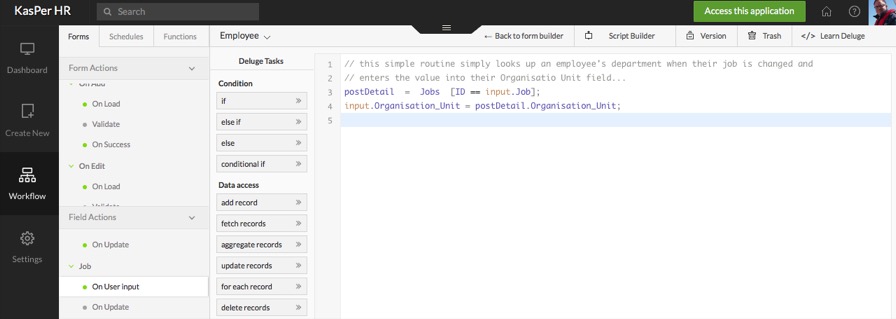
As you can see, this takes just two lines of code (the first two are just comments).
'Reports' can also contain 'Custom Actions' which can be represented in the User Interface as buttons or menu options as you require. For example, this Leave to be Approved report contains two buttons which will approve or reject an employee's leave request:

If the approver clicks a button then this runs a Deluge 'Function' which will action their request. Here is the code which will mark a leave request as Approved:

I've generally found Deluge to be a very effective language so far and certainly up to hailing some of the complicated calculations involved in Absence Management.
I will cover some examples of Deluge coding in future articles in this Blog.
Integration
As you would expect, Creator provides tools to integrate your apps with most of the solutions in the Zoho suite of products. There are also inbuilt integrations with Salesforce, Box, DropBox, OneDrive, Calendars, Quickbooks, PayPal , etc. In addition Deluge has the capability to interact with APIs and you are also able to use Zapier to integrate with other apps.
Conclusions
I must start my conclusion section by admitting that I have recently passed my Zoho Certified Developers exam and am now a Zoho Certified Solution Provider. I decided to go down this path because I felt that Creator provides a strong set of tools with which to build software for both in house use and for customers. With the imminent end of Access Web Apps, I feel that this, along with Airtable and Podio, provide me with a fantastic set of options with which to address customer requirements.
How does Creator fit in with the other tools I have reviewed? I would say that Creator is quite similar to Access in one respect in that it has a relatively gentle learning curve - but is also a comprehensive product which can handle a wide range of challenges. Of the products I am actually working with, it is the tool I would choose to handle something which needs to be quite structured, secured and controlled. This is in contrast to Airtable which is more of an ad-hoc database tool (which users really like to work with) - or Podio which focusses on collaboration and workflow around your data.
I have found Zoho's support to be excellent (and there is loads of documentation and help available) and there's also a forum where users can communicate and help each other. Zoho also has a Marketplace where developers can put their solutions - so there are a growing number of 'off the shelf' solutions based on the platform.
With my recent experience with Access Web Apps, I am also very concerned about the future of any platforms I work with. Since working with Creator it is already apparent that there is significant continuing development going on and this gives me confidence to recommend it if you are looking for a tool to build solutions for your business.
Finally, there are a number of licence plans available (including a Free plan which may well provide all you need).
I hope to be adding additional articles to the blog in the coming months covering specific Creator features and techniques in more detail.
Within the Zoho suite, Creator is the tool you would use to build solutions which are specific for your business - and where simply customising one of their other services wouldn't meet your needs. There are a huge number of options in Creator and I will only be able to scratch the surface in this review but I hope that, by the end, you will have a good idea of its capabilities.
Getting Started - Building your first App
Creating a new app starts from the Creator home page - from where you can click New Application. As with some of the previous reviews, I am going to base this review on an HR app - one, in fact, that I am actively working on for the Zoho Marketplace - which I've named KasPer HR.

With Zoho, you start by building 'Forms'. This process creates both a form which is used for adding and editing data and also the underlying database table and all its fields. Here is an example of the dashboard within Creator where you can see all the forms and other items in the app:

Let's have a look at the Employee 'Form':

Hopefully, you can see the wide range of options available for the form overall - as well as the number of different field types including file upload, images, formula fields, signatures etc. Some of these are mobile enabled - you can capture signatures and take photos on your device for example. There's plenty of flexibility here to store all your data! In run mode this form looks like this:

When you create a 'form' the system also creates an associated Report which are used to navigate through records, select records for single or batch edits, delete, etc. Reports can also be displayed in a number of formats (Lists, Calendars, Charts, etc) and you can perform groupings, selections and so on. Here is a screenshot of a basic list report based upon Employees:
In Design View:

And this is what it looks like at runtime:

This is effectively the default report for this Form - and includes all fields in the form. You have a number of ways to customise this - for example you can hide fields by either removing them from the report in design view or, using the Eye symbol top left you can remove them in runtime. In design view you can also add grouping, sorting and selection criteria:

Here, for example, I am grouping by 'Organisation Unit' and sorting by Full Name.
In the Filter section, you can enable and disable default filtering options available to users of the application and also build custom filters for the report:

If you wanted to provide a custom filter for your users which would limit the report to only Current Employees (assuming you had a tick box for this) you would do this:

When the report is run, users can choose to apply the filter:

There are many more options for your reports including which users can access them, conditional formatting, 'custom actions' (more later), etc. The employee listing below, for example, has leavers greed out and some buttons which perform 'custom actions':

Relating Data
Relational data is fully supported within Creator and is simple to configure - by simply adding a Lookup field to a child record for example. Once you have your relationship, you can manipulate related data, add to forms in Subforms and perform sums and calculations.
You should be aware that one feature missing is the ability to perform automatic cascade deletes when a 'parent' record is removed from the database. However, it is very easy to implement this is Creator's Deluge Language with a Deluge script associated with the Validate action when a record is deleted:

In this example, records are deleted from two 'sub' tables (which would otherwise be 'orphaned').
Business Intelligence and Dashboards
We have already seen how you can produce listing and other reports (eg. Calendars or Grid views) which can be used for both information display and system navigation purposes. You are also able to create Pivot Charts and Pivot Tables - which are great ways of presenting information to users - and in Creator these also have drill down capabilities allowing users to see what's behind the presentation. There are helpful features when dealing with dates so that information can be displayed by - here's an example grouped by month for an Absence by Month graph:

And this is what the end result looks like:

Notice how the legend can be used to filter the graph by simply selecting and deselecting the leave type.
In addition to reports in their various formats, you also have the ability to create 'Pages' which enable you to group data from multiple reports (or retrieved using Deluge) on a single page. This enables the production of multi faceted dash boards and navigation scenarios. Pages are created with a combination of HTML and Deluge script together with drag and drop editing (especially with the New Page Builder currently being beta tested).
Mobile
As I mentioned briefly above, Zoho Creator includes a mobile app with which your solutions can be used on a mobile device (iOS, Android - phone and tablet) without modification - even with Offline mode if you are on a premium account or above!
This takes the form of a (free) app from the relevant app store which acts as a container for your Zoho Creator solutions, showing you a list of your apps and allowing full use of them on the move:

The middle screenshot shows a list of your apps and we also have a screen in edit mode, a Calendar, a Report listing employees and an example of a graph (Absences by Month - which is the same as that shown above so that you can compare).
With this latest update to the mobile app (released around 25th April 2017), usability on a phone has improved significantly. I believe Zoho really understand the importance of being able to build Web and Mobile solutions using the same tooling and techniques.
Style and Layout
I have shown all of the example screenshots so far using the same Theme - but there are a number of options available - here is an alternative showing red highlights and the menus down the left:

Security
Creator has comprehensive built in security (with more features available in the Paid plans) and is clever enough to automatically hide things from users if they don't have access. This means that is is fairly easy to build a solution with multiple use cases for different groups of users.
Subject to your plan, there is also a feature called 'Customer Portal' which allows you to build an unbranded portal for external users. This can also be fully secured and users can be allowed to either create their own accounts or they can be created for them.
Customisation and Coding
Zoho has a lot of flexibility when it comes to laying out your menus and structuring your application (especially through the judicious use of Pages).
I would personally describe Zoho Creator as a Low Code platform (rather than No Code) as it has its own language called Deluge. This language is really at the core of the product and can handle quite complex business logic in a remarkably small number of lines of 'Code'. Getting familiar with the language is aided by the two script editing modes - using the Script Builder is the way to start for most users as it prompts you for all the options needed for each statement. Once you are reasonable familiar you can then start to use Free Flow Scripting (which still assists along the way).
You will probably start with Deluge writing Field Actions which are triggered when a user updates a field (for example) - here is an example which runs when a user changes an employee's Job in my HR app:

As you can see, this takes just two lines of code (the first two are just comments).
'Reports' can also contain 'Custom Actions' which can be represented in the User Interface as buttons or menu options as you require. For example, this Leave to be Approved report contains two buttons which will approve or reject an employee's leave request:

If the approver clicks a button then this runs a Deluge 'Function' which will action their request. Here is the code which will mark a leave request as Approved:

I've generally found Deluge to be a very effective language so far and certainly up to hailing some of the complicated calculations involved in Absence Management.
I will cover some examples of Deluge coding in future articles in this Blog.
Integration
As you would expect, Creator provides tools to integrate your apps with most of the solutions in the Zoho suite of products. There are also inbuilt integrations with Salesforce, Box, DropBox, OneDrive, Calendars, Quickbooks, PayPal , etc. In addition Deluge has the capability to interact with APIs and you are also able to use Zapier to integrate with other apps.
Conclusions
I must start my conclusion section by admitting that I have recently passed my Zoho Certified Developers exam and am now a Zoho Certified Solution Provider. I decided to go down this path because I felt that Creator provides a strong set of tools with which to build software for both in house use and for customers. With the imminent end of Access Web Apps, I feel that this, along with Airtable and Podio, provide me with a fantastic set of options with which to address customer requirements.
How does Creator fit in with the other tools I have reviewed? I would say that Creator is quite similar to Access in one respect in that it has a relatively gentle learning curve - but is also a comprehensive product which can handle a wide range of challenges. Of the products I am actually working with, it is the tool I would choose to handle something which needs to be quite structured, secured and controlled. This is in contrast to Airtable which is more of an ad-hoc database tool (which users really like to work with) - or Podio which focusses on collaboration and workflow around your data.
I have found Zoho's support to be excellent (and there is loads of documentation and help available) and there's also a forum where users can communicate and help each other. Zoho also has a Marketplace where developers can put their solutions - so there are a growing number of 'off the shelf' solutions based on the platform.
With my recent experience with Access Web Apps, I am also very concerned about the future of any platforms I work with. Since working with Creator it is already apparent that there is significant continuing development going on and this gives me confidence to recommend it if you are looking for a tool to build solutions for your business.
Finally, there are a number of licence plans available (including a Free plan which may well provide all you need).
I hope to be adding additional articles to the blog in the coming months covering specific Creator features and techniques in more detail.
blog comments powered by Disqus